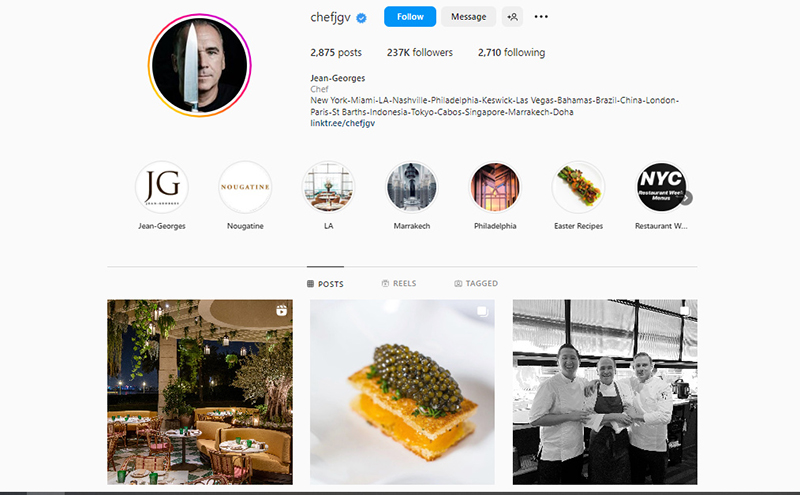Are you looking for innovative ways to level up social media marketing for your restaurant? Earlier, social media has not always been part of restaurant marketing. In the past, paid advertisements, signs, flyers, word-of-mouth, and customers walking by were considered the best ways to create awareness about a restaurant. However, with evolving digital marketing trends, restaurant social media marketing has become an important strategy for being online, across multiple platforms. Adopting smart ways to improve SEO across several social platforms can help get restaurant businesses back on track, retain clients, and improve brand recall. Choosing the right social media marketing services to manage the online/offline presence of a restaurant is another important aspect. In fact, the right social media marketing strategies can help achieve high search engine rankings and place the restaurant in front of thousands of potential customers.
Generally, people who are interested in discovering new restaurants and tasting a variety of foods will definitely perform a detailed Google search to find the best restaurants near them. According to a survey done by Social Media Today, 30 percent of millennials avoid restaurants with a weak social media presence, especially on Instagram. In fact, about 63 percent of restaurants use social media as their main method of advertising. With an increasing number of social media users nowadays, a weak social media marketing strategy can negatively affect the revenue and long-term success of a restaurant.
Key Restaurant Social Media Marketing Strategies
Here discussed are some of the key social media marketing strategies that can help restaurants improve their online presence –
- Choose the Best Platform to invest in – With limited time and resources, most restaurants cannot show their presence across all platforms. Most restaurant marketers fall into that category, and they need to prioritize accordingly. It is a known fact that each social media platform has its own audience, tone and culture, but never stress about perfectly tailoring every post to every channel. Therefore, it is better to choose one specific platform to invest in, learn which type of content works best, and develop content that specifically caters to that specific user base.
- Refine the Brand Voice and Tone – Generally, social media is more causal and conversational when compared to other marketing channels. The key aspect is to find the right balance that adapts, but doesn’t abandon, the restaurant’s larger voice and tone. If a restaurant already has a brand voice or tone that needs polishing, it is important to take the job seriously. As restaurants with a top social media game stand out with their voice, it is important to consider certain aspects such as – who will be the target audience group, what language/tone do they speak and the current customer base. In addition to finding or refining the brand voice, it is best to brainstorm 2-3 brand voice traits that showcase the restaurant’s personality and will also resonate with the targeted dining groups.
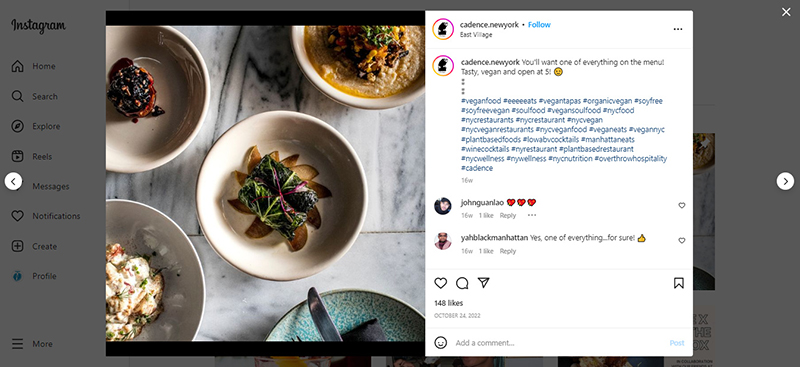
- Define Visual Style – Defining a clear visual style is an important aspect that becomes instantly recognizable to your followers. Compared to other industries, restaurants have a built-in advantage on social media. Food photography is one of the most popular content types. High-quality visuals communicate a memorable story. When it comes to food menus, appetizing photos or images are often the driving force in attracting the audience’s attention. The vast majority of content gets viewed in the feed. A perfect visual style looks great in both places, but a concept that works in the feed but not the grid is more effective.
- Prioritize Short, Vertical Videos – Short, vertical videos shot on smartphones have emerged as one of the most popular content online. Social media platforms such as Instagram and Facebook have launched reels to gain more organic reach. The benefit of vertical video is that anyone can shoot it and because so many people do, users are conditioned to seeing less expensive, more realistic production value. This has democratized video content creation and allowed even resource-strapped businesses like restaurants to shoot varied types of video content.
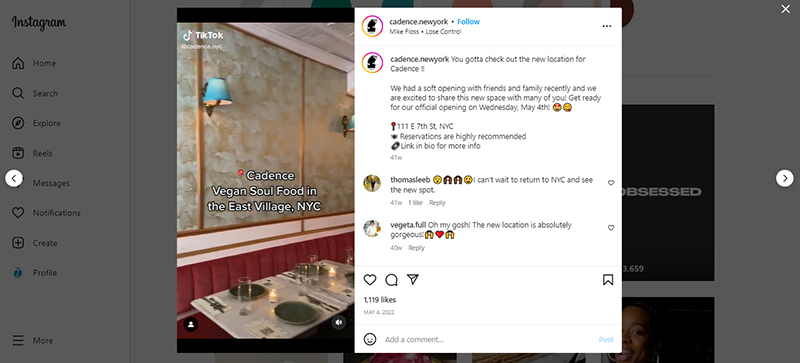
- Create Recurring Series – Creating recurring content series is another good strategy. Recurring content series give users a reason to follow a specific restaurant account and create a sense of what to expect after they do. It also make it easier for restaurants to plan content, since they don’t have to start from scratch every time they build a content calendar. Restaurant marketers can start by planning the next several installments of the series, instead of a completely blank page. For instance, Brooklyn-based pasta restaurant “Lilia” creates a series of Instagram Reels called the “Mafaldini flip.” In fact, each installment is a short, slow-motion video of a different staff member flipping the restaurant’s Mafaldini dish in the pan. Each video is also set to a different song. This simple, recurring series reinforces the artistry Lilia puts into its dishes, showcases its personality, and highlights its team culture.
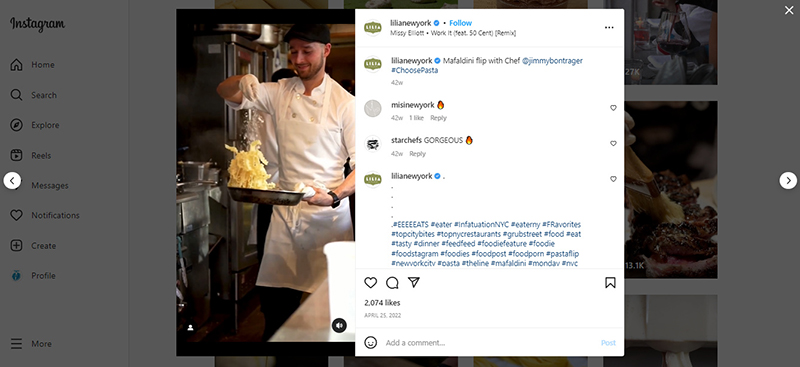
- Post at a Consistent Pace – Making top-quality content posts consistently on social media platforms is one of the effective ways to grow a social account. Social algorithms actually favor the “authentic” aesthetic created by less polished content. This is one of the many reasons why a restaurant’s workplace culture matters. When a restaurant staff feels like a team, they can work together to proactively find content opportunities.
- Interact with Specified Social Community – Earlier, social media was largely a peer-to-peer communication channel. However, it has now evolved into more of a content consumption channel – where people discover, follow and binge videos from “creators” they have not met. It is important to connect and engage with the customers, especially for restaurants, which excel in the hospitality field. It is vital to respond to direct messages. Repost photos that a restaurant gets tagged in. Comment back and start a conversation. A positive back-and-forth communication on social media platforms helps build goodwill and relationships in an industry built on them.
- Add Complete Details to the Social Media Page – Generally, more people tend to view the content in the feed than on the page. However, that doesn’t mean that you should neglect the main page because the main page can still drive a good amount of traffic or users and those users are particularly valuable as the number of clicks on a profile generates a strong signal of interest. A well-designed social page can satisfy that interest with details about the restaurant and features designed to convert users into customers. The page should include a detailed restaurant description; story highlights that answer FAQs, and a link that drives back to the restaurant website – as this can all help diners learn more about the restaurant. These details can help people place orders directly through their social apps. This removes the extra hassle of bouncing between platforms as they will be processed through the same online ordering system as other direct orders.
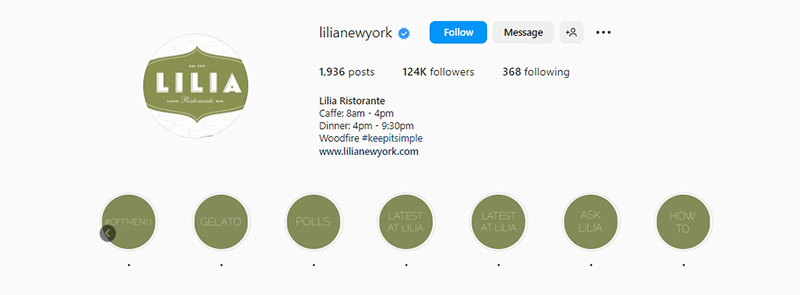
- Use Paid Campaigns to Amplify Top Posts – Organic social media posts typically reach just 10-20 percent of followers (though it varies a bit by channel). However, that 10-20 percent consists of most engaged audiences. Certain campaigns require reaching people outside the core community. Key examples of paid campaigns include – limited-time promotions (where a special item or deal can help acquire first-time diners), new location openings and key events and partnerships. Paid social content is a little different as they are allowed to upload multiple pieces of content (known as ad creatives) and run them as part of the same campaign. The social network’s algorithm will spend a little budget on each piece of content (enough to get a statistically meaningful sample) and then apply the rest of the budget to whichever drives the best performance.
In a highly competitive restaurant industry, social media is one tool that can be utilized to help businesses stand out in their arena. Creating social media profiles across multiple platforms can be a major part of a restaurant’s digital marketing strategy as this helps showcase the features of a restaurant and create a greater online presence. Following the above-mentioned strategies can help restaurant brands to have a great headstart into the complicated world of restaurant SEO. Outsourcing social media marketing is the best way to create a unique plan that is tailored to the specific target audience groups of a restaurant.
| At MedResponsive, we work to improve your brand recognition and take your business to the next level. We provide digital marketing for businesses, bringing more visitors to your website and turning them into customers. |


